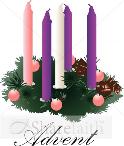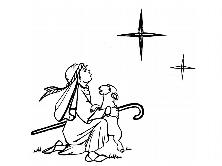Advent and Christmas

THE CHRISTMAS SEASON
Here is a short explanation of some of the main celebrations to be found during the Christmas season
Advent
Advent, the first season of the Church's year, begins on the Fourth Sunday before Christmas. It is a time of preparation and hope, looking both to the coming of the Birth of Jesus at Christmas, and also to his Coming Again in Glory at the end of time, when all things will be gathered up in him and offered to God the Father.

Most Anglican Churches hold a Christingle Service at the beginning of Advent. The
Christingle is made up of an orange, wrapped in ribbon, with a small
lit candle and dried fruits or sweets inserted into the orange flesh
and skin. The dried fruit and sweets are secured to the Christingle
orange using four cocktail sticks. It is designed to appeal to children
and each part of the Christingle symbolises:
• The orange represents the world.
• The lighted candle represents Jesus Christ who is seen as the Light of the World who shows us God's love.
•
The red ribbon wrapped around the Christingle orange is a symbol of the
blood of Jesus Christ which was shed for our sins, so it is a symbol of
forgiveness.
• The dried fruit and sweets represent the four
seasons of Spring, Summer, Autumn and Winter and the fruits of the
earth. (Some say the four points of the compass of North, East, South
and West to represent the good things the world provides).
There are many traditions surrounding the Advent season. These include:
Advent Ring / Advent Candle
The Advent Ring consists of a large or different coloured candle, usually white or gold, placed in the centre of a circle of holly, evergreens, ivy and fir to form a wreath. The circle of the wreath represents ongoing life. Four coloured candles are placed around the middle candle, near to the outside of the wreath ring. On each Sunday prior to Christmas Day the four outer candles are lit during church services, each in turn for each of the four Sunday’s. i.e on the first Sunday one candle is lit, on the second two are lit, on the third three are lit and four are lit on the fourth Sunday. The middle candle, which symbolises Jesus Christ, is lit on Christmas Day.
The first candle represents the Patriarchs, Abraham, Isaac and Jacob, the first people to be called by God; the second represents the Prophets of the Old Testament, who foretold the coming of the Saviour; the third candle represents John the Baptist, who prepared the people for the coming of Jesus, and was the first to recognise him when he came; the fourth candle represents the Blessed Virgin Mary, who accepted the invitation of God to become the Mother of his Son.
Advent Calendars
Modern children (and some adults!) enjoy opening an advent calendar window each morning from the 1st of December through to the 24th of December, though some have a special window for Christmas Day. Some advent calendars have a picture behind the window, sometimes with a festive or religious message. In others, the windows open to reveal small piece of chocolate shaped into a star, Christmas tree, snowman, etc. Advent calendars originated in Germany in the late 1800s.
Advent Candles

These work on the same principle as an advent calendar in that a decorative candle is marked off with 25 special markings or numbers and the candle is lit each night and the day's length is burnt. The candle is then lit on the 25th and completely burnt.
CHRISTMAS DAY

Christmas Day is one of the most important days in the Christian Church calendar. It is the day that we celebrate the birth of Jesus in Bethlehem. The Story of Jesus' birth, or nativity, is told in the Gospels of St Matthew and St Luke.
In our Church, as in most Churches throughout the world, Christmas Day services begin with a Midnight Mass late on Christmas Eve.

Christians believe that Jesus is Son of God and Son of Mary, so both human and divine. In Jesus, God enters into the world he has made and which he loves so much, taking into himself our human nature, with all that that means: the joys and sorrows of human living and loving. This shows how much God loves and values the beautiful world and the beautiful creatures he has made. Jesus even shares our death too, so that we might rise with him to new and eternal life, although we learn more about that in the Easter story. One of the first Christian teachers wrote that 'the Son of God became the Son of Man, that the sons of men might become the sons of God', or as we might put it nowadays, 'the Son of God became a human being, so that human beings might become the children of God.'
What an amazing and wonderful thing it is, that God, the Lord of all, should become a tiny, vulnerable baby...!
